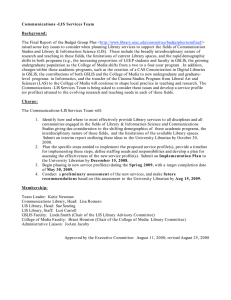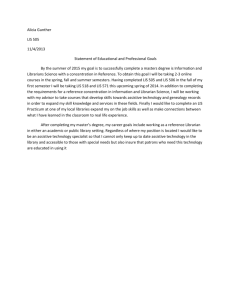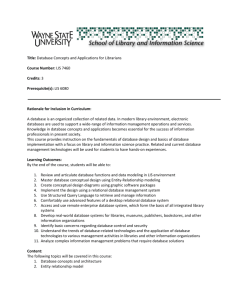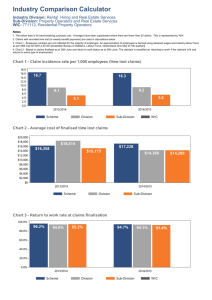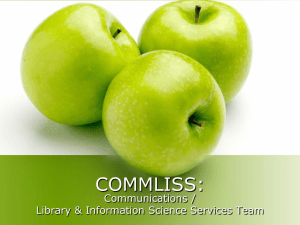--- DRAFT 2 ---
advertisement
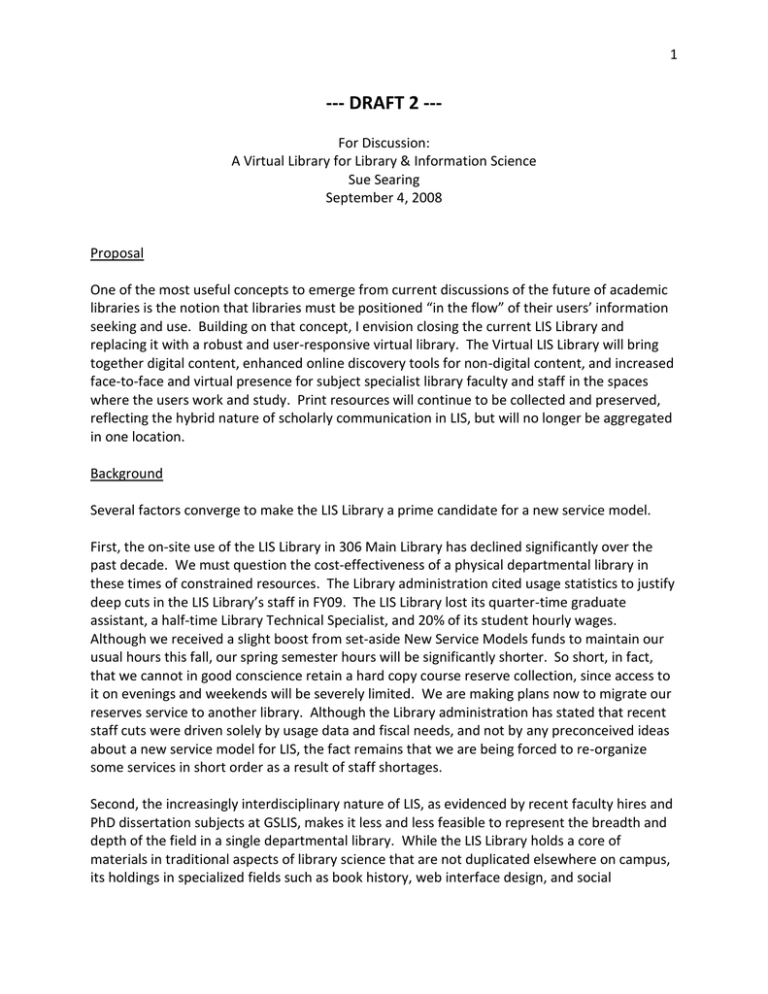
1 --- DRAFT 2 --For Discussion: A Virtual Library for Library & Information Science Sue Searing September 4, 2008 Proposal One of the most useful concepts to emerge from current discussions of the future of academic libraries is the notion that libraries must be positioned “in the flow” of their users’ information seeking and use. Building on that concept, I envision closing the current LIS Library and replacing it with a robust and user-responsive virtual library. The Virtual LIS Library will bring together digital content, enhanced online discovery tools for non-digital content, and increased face-to-face and virtual presence for subject specialist library faculty and staff in the spaces where the users work and study. Print resources will continue to be collected and preserved, reflecting the hybrid nature of scholarly communication in LIS, but will no longer be aggregated in one location. Background Several factors converge to make the LIS Library a prime candidate for a new service model. First, the on-site use of the LIS Library in 306 Main Library has declined significantly over the past decade. We must question the cost-effectiveness of a physical departmental library in these times of constrained resources. The Library administration cited usage statistics to justify deep cuts in the LIS Library’s staff in FY09. The LIS Library lost its quarter-time graduate assistant, a half-time Library Technical Specialist, and 20% of its student hourly wages. Although we received a slight boost from set-aside New Service Models funds to maintain our usual hours this fall, our spring semester hours will be significantly shorter. So short, in fact, that we cannot in good conscience retain a hard copy course reserve collection, since access to it on evenings and weekends will be severely limited. We are making plans now to migrate our reserves service to another library. Although the Library administration has stated that recent staff cuts were driven solely by usage data and fiscal needs, and not by any preconceived ideas about a new service model for LIS, the fact remains that we are being forced to re-organize some services in short order as a result of staff shortages. Second, the increasingly interdisciplinary nature of LIS, as evidenced by recent faculty hires and PhD dissertation subjects at GSLIS, makes it less and less feasible to represent the breadth and depth of the field in a single departmental library. While the LIS Library holds a core of materials in traditional aspects of library science that are not duplicated elsewhere on campus, its holdings in specialized fields such as book history, web interface design, and social 2 implications of information systems--to name just three salient interdisciplinary foci of the GSLIS curriculum and research agenda--are necessarily complemented by the holdings of numerous other departmental libraries. Third, the transition from a mostly-print to a mostly-digital information environment is well underway in LIS. Informal self-reports of information-seeking habits reveal that most LIS Library users access our services and collections predominantly through online channels. The journal and report literature in the field has almost totally migrated to web-based dissemination, and, in order to serve the LEEP community well, the LIS Library has been aggressive in acquiring online access whenever possible. Reference books and monographs are migrating more slowly, but we are building sizeable digital collections of these publication types too through purchase, licensing, and local digitization efforts. We deliver services like course reserves, reference, and information literacy instruction both face-to-face and via the web. Fourth, the LIS Library has already taken some small steps to break out of the traditional mold. On the service front, I instituted regular office hours at GSLIS more than two years ago. Office hours have proved quite successful as a way to deliver reference and instructional services to faculty and students – so successful that Dean Unsworth moved me from a room shared with emeritus faculty, adjunct faculty and visiting scholars, to an office of my own in a high-traffic area. GSLIS has clearly demonstrated its support for an “embedded” librarian. On the collections front, in collaboration with Nancy O’Brien, I am permanently transferring all books and serials related to children’s and young adult literature, along with the funds to support ongoing acquisitions in this sub-field, from the LIS Library to the Education & Social Science Library. This consolidation benefits students and researchers in several departments. (Materials related to youth services in libraries continue to be the responsibility of the LIS Library.) As part of the New Service Models initiative, two proposals have been advanced for combining the LIS Library with other departmental libraries. The interim report recommended a consolidation with the Education and Social Science Library, while the final report recommended a merger with the Communications Library to create a “Media & Information Studies Library.” Either proposal would necessitate downsizing the existing LIS Library collection, as well as the collection of the receiving library, in order to fit into their pre-existing space. Additional staff and readers would create more stress on already crowded facilities. In my opinion, consolidation without space expansion will only degrade services for all constituencies of the affected libraries. The time has come to ask whether a focused print collection, either independent or integrated with other disciplines, is really the best approach to serving LIS students and researchers. There are risks in abandoning the old model and embracing a new one, but having considered the alternatives proposed, I believe that a bold and progressive approach to change is better than a slow absorption and decline. 3 Potential positive outcomes A content-rich and feature-rich portal to LIS information, accessible from anywhere, that exceeds the offerings of the current LIS Library website. Models for such a portal include the “virtual library” websites for gender studies, biotechnology, labor and employee relations, and global studies. Greater ability for users to customize their view of LIS information through RSS feeds and other technologies. Improved access to relevant LIS content by information seekers outside the Library and GSLIS. More opportunities for members of the GSLIS community to have direct contact with the specialist librarian and library staff in their own surroundings (LIS Building). Better service to online learners, especially in the LEEP program. Ability of the University Library to reassign rooms 306-312 Main Library. Increased flexibility in staff allocations within the University Library. A test bed for piloting new forms of information access that might later be expanded to the entire University Library. Potential negative outcomes Loss of intermediaries who can quickly resolve library users’ problems with, for example, course reserves or overdues. (GSLIS faculty, in particular, have expressed this fear.) Diminished support for research and evidence-based professional practice within the University Library. (Library faculty, in particular, have expressed this fear.) Gradual reduction in the quality of the print collection, and in funding for it, if it is no longer developed and maintained as a unique library. (Both Library and GSLIS faculty have expressed this fear.) Loss of individual and group study space in which GSLIS students feel particularly welcomed. Loss of a “home base” for some LEEP students during their on-campus sessions. Loss of familiarity with print resources on the part of the librarian and staff members; such knowledge comes naturally from examining new books and journals as they arrive in the departmental library. Inability to respond quickly to reference queries most easily answered by recourse to print sources. Loss of the physical library’s iconic value to the University. The existence of a worldclass special collection legitimates the field and reflects UI’s proud tradition of LIS scholarship. 4 Baseline requirements to maintain a virtual LIS Library Full-time subject specialist librarian. Full-time staff member with knowledge of the discipline and the user community. Graduate assistant or graduate hourly with advanced web and database skills, OR dedicated support from Library and/or GSLIS IT staff. Increase to current collection development budget (permanently recurring funds) to enable more online acquisitions and content licensing. Continued commitment to a research-level collection in LIS in all formats and media. Physical space for personnel, suitable for consultation with LIS information seekers, in the places where those users cluster (i.e., GSLIS and the Main Library). Special considerations Inevitably hurdles will arise during the transition from a traditional to a virtual library. Among those I can foresee now are: While a portion of the current collection will find natural homes in other departmental libraries, the core of materials on library science will likely be housed in the Main Library stacks. At present, the location of the 020-028 call numbers on Desk 2 East is inhospitable (low ceilings, poor lighting, inadequate reader spaces). These call numbers must be shifted to a better area of the stacks before current LIS materials are placed there. Under the current shifting schedule, I have been told, it will be several years before this is accomplished. Non-circulating reference books currently housed in the LIS Library must find homes in other reference collections. The Cataloging Table brings together print tools and reference works that must be consulted in advanced cataloging assignments. This “lab” environment must be preserved, perhaps at GSLIS rather than the library. To provide service to Library faculty and staff, Sandy Wolf and I will need to maintain an office in the Main Library. This space should also accommodate the storage and processing of gift collections. The LIS Library Virtual New Books Shelf is a unique service that our users value highly and prefer to the customized new book lists generated via Voyager. The workflow to maintain the Virtual New Books Shelf is dependent on the receipt of new books for our physical collection. If this much-loved service is to continue, a different workflow must be set up. We have an implied consortial responsibility as a provider of LIS materials within Illinois. While licensing agreements for electronic journals increasingly allow for resource sharing, such sharing of e-books is not generally feasible at present, nor are the longterm preservation issues for commercial or open access e-books being addressed as vigorously as for e-journals. In the short term it is desirable to duplicate print and online book content when possible and affordable.
